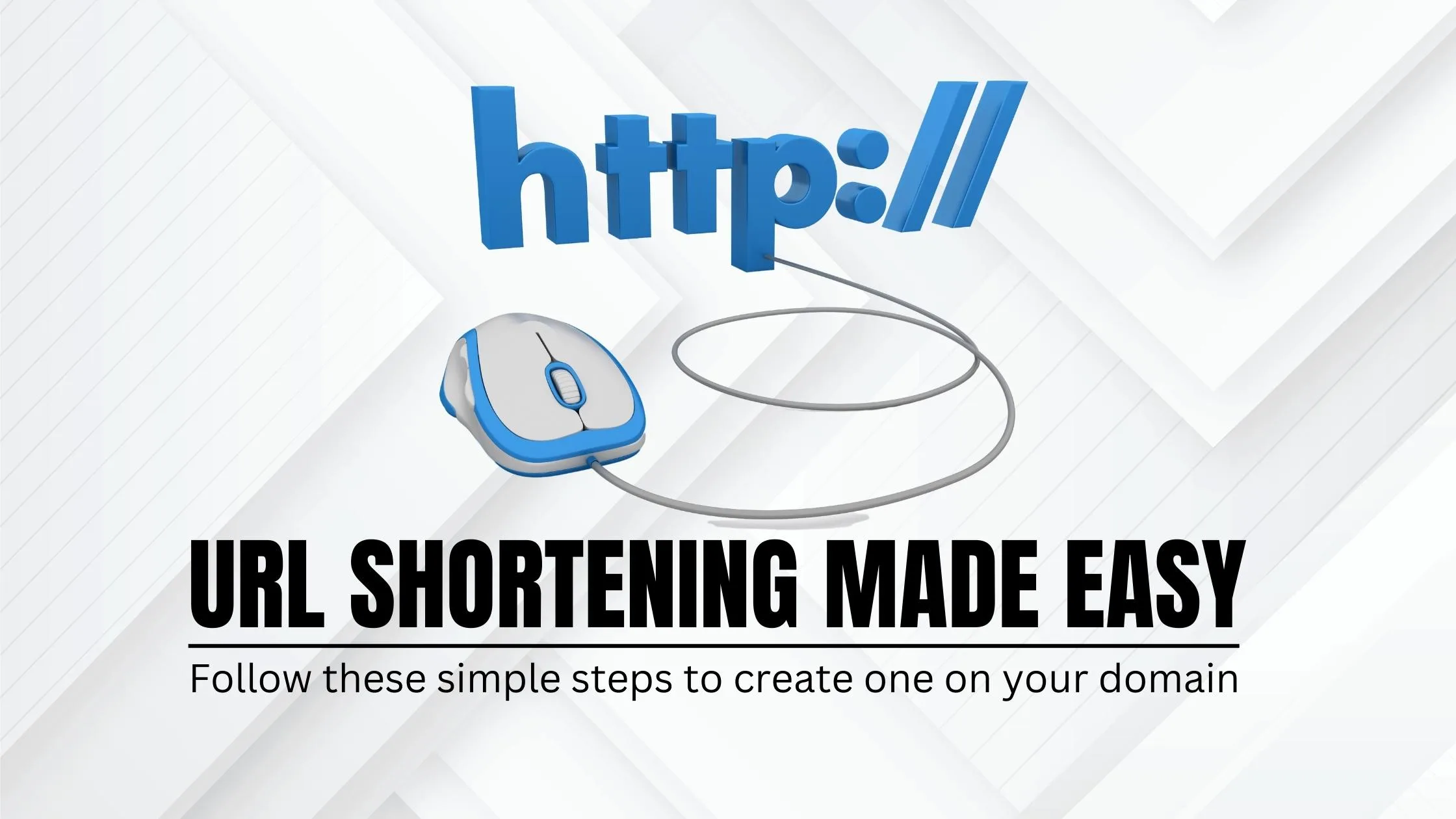URL Shortening Made Easy: Follow These Simple Steps to Create One on Your Domain
Are you tired of long and complicated URLs that are difficult to remember or share? Look no further, because URL shortening is here to save the day! In this blog post, we’ll guide you through a simple process to create your own custom short links on your domain.
With just a few easy steps, you can transform those lengthy links into sleek and memorable ones that will enhance your brand and make sharing content with others a breeze. Let’s get started!
What is URL Shortening?
A URL shortener is a web service that provides a short, uncluttered link that redirects to a longer, messier link. This is useful for tidy backlinking, social media, and other places where long URLs just don’t look good. For example, bit.ly is a popular URL shortener.
Most URL shorteners will give you the option to create custom links with your own branded domain name. For example, you could use “yoursite.com/go” as your URL shortener instead of “bit.ly/2FAb123”. This adds an extra level of professionalism and branding to your shortened links.
Creating a URL shortener on your domain is actually quite simple. Here are the steps:
1) Choose a web hosting provider and register your domain name with them. We recommend using WordPress hosting providers like WP Engine or SiteGround. They offer great features specifically for WordPress websites, and they’re reasonably priced.
2) Install the YOURLS software on your web server. YOURLS is open source software that allows you to create your own URL shortening service. It’s free to download and use.
3) Configure YOURLS according to the instructions on their website. This includes setting up a database for YOURLS to use, creating an administrator account, and choosing some basic settings for your service.
4) Start sharing your shortened links! You can use the YOURLS admin tool to create short URLs for any page on your website, or you can use the provided API to integrate your service with other applications.
URL shortening services make it easier and more organized to share long URLs, which is especially useful when you’re using social media or email marketing. Plus, customizing your own URL shortener looks professional and adds extra branding.
Benefits of URL Shortening
1. URL shortening can help you save time and money.
2. URL shortening can improve your website’s search engine optimization (SEO).
3. URL shortening can make it easier for people to share your content on social media.
4. URL shortening can help you track clicks and analyze traffic data.
How to Create Your Own URL Shortener
Assuming you have your own domain name, creating your own URL shortener is a simple process. By following these steps, you can create a URL shortener that will work on your domain:
1. Choose a web host and set up your website. This is where you’ll create and store your shortened URLs.
2. Find or create a script for your URL shortener. There are many scripts available online, or you can create your own using a programming language like PHP.
3. Set up the script on your web host. This will usually involve uploading the files to your server and configuring them to work with your domain.
4. Create shortened URLs! Once everything is set up, you can start creating shortened URLs for use on your website or anywhere else on the web.
– Step 1: Choose a Domain Name
If you want to create a URL shortener on your domain, the first step is to choose a domain name. The domain name should be short and easy to remember, as people will need to type it into their browser to use your service.
Once you have chosen a domain name, you will need to set up a web server on that domain. You can use any web server software, but we recommend using Apache or Nginx.
Once your web server is set up, you will need to install the URL Shortener script. This script will handle the shortened URLs and redirect them to the correct destination.
There are many scripts available online, but we recommend using TinyURL Shortener (https://github.com/kamilsk/tinyurl). It is open source, easy to install, and easy to use.
Once you have installed the script, you will need to configure it. The most important setting is the “Base URL”, which is the part of your domain that will be used for shortened URLs. For example, if your Domain Name is “example.com” and you choose “/short” as your Base URL, then shortened URLs will look like “example.com/short/ABCDEF”.
The next setting is the “URL Length”. This determines how long the shortened URLs will be. The shorter the length, the easier they will be to remember, but longer lengths allow for more flexibility in choosing destination URLs. We recommend setting the URL Length to 8 characters.
After configuring the script, you will need to test it to make sure it works correctly. You can do this by creating a few shortened URLs and visiting them in your browser. If they redirect properly, then your URL Shortener is ready for use!
– Step 2: Identify the Right Platform
There are a number of different URL shortening platforms available, so it’s important to choose the one that’s right for you. Here are some things to consider when making your decision:
– Ease of use: Choose a platform that’s easy to use and doesn’t require any technical knowledge.
– Features: Make sure the platform you choose has all the features you need, such as custom branding, link tracking, and password protection.
– Pricing: Compare the prices of different platforms to find one that fits your budget.
– Step 3: Set Up Your Domain and Server
Assuming you have a domain name and hosting, the next step is to set up your URL shortener. Many domain registrars offer free URL shorteners with their services. If yours doesn’t, there are plenty of third-party options to choose from.
Once you have your URL shortener set up, you’ll need to create a shortened URL for each page on your website that you want to share. To do this, simply enter the full URL into the URL shortener and click “create.” The shortened URL will then be generated for you to use.
To share your shortened URLs, simply copy and paste them wherever you want to share them (social media, email signatures, etc.). When someone clicks on the shortened URL, they will be redirected to the original page on your website.
– Step 4: Customize Your Settings
Assuming you have your DNS and web server set up and running, the next step is to download a URL shortening software package. There are many options available, but we recommend using the popular Shorty package. Once you have Shorty installed, follow these instructions to get started:
1. Edit the file config/shorty.yml and change the base_url setting to point to your own domain name. For example:
base_url: http://example.com/
2. Create a database and update the database settings in config/database.yml accordingly. Shorty supports MySQL, PostgreSQL, and SQLite3 databases.
3. Run theShorty migrations to create the necessary database tables:
$ rake db:migrate
4. Start the Shorty server:
$ rails server
Tips for Optimizing Your Short URLs
1. Keep it short and sweet: The shorter your URL, the easier it is for users to remember and type into their browser.
2. Use keyword-rich keywords: Choose keywords that accurately describe your content and are likely to be used in search engines. This will help users find your content more easily.
3. Make it easy to read: Use a simple, straightforward URL that is easy for users to understand. Avoid using abbreviations or acronyms that could be confusing.
4. Use lowercase letters: Using all lowercase letters in your URL makes it easier to read and eliminates the potential for confusion caused by uppercase letters.
5. Include relevant keywords: In addition to using keyword-rich keywords, including relevant keywords in your URL can help users find your content more easily.
6. Avoid special characters: Special characters can be confusing and make it difficult for users to remember your URL. Stick to using only letters and numbers in your URL.
Troubleshooting Common Issues with URL Shorteners
If you’re having trouble with your URL shortener, there are a few common issues that you can check. First, make sure that your URL shortener is properly set up and configured. Second, check to see if your URL shortener is being blocked by your web server. If you’re still having trouble, contact your URL shortener provider for help.
Conclusion
URL shortening can be a great way to make sharing long URLs easier and more efficient. By following the steps outlined in this article, you’ll be able to set up your own URL shortener on your domain and start using it right away. With its many benefits, creating a custom URL shortener is definitely something worth considering for any business or individual looking to streamline their web presence.





